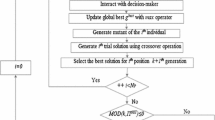Abstract
Due to mounting infiltration of solar and wind energy sources, it becomes essential to investigate its brunt on the dynamic economic dispatch. Here, solar–wind–thermal system integrating pumped-storage hydraulic unit has been considered. This work recommends chaotic fast convergence evolutionary programming (CFCEP) rooted in Tent equation for solving dynamic economic dispatch problem incorporating renewable energy sources and pumped-storage hydraulic unit. Chaotic sequences increase the exploitation ability in the searching space and enhance the convergence property. In the recommended technique, chaotic sequences have been pertained for acquiring the dynamic scaling factor setting in fast convergence evolutionary programming (FCEP). The efficiency of the recommended technique is revealed on two test systems. Simulation outcomes of the suggested technique have been matched up to those acquired by FCEP, differential evolution and particle swarm optimization. It has been observed from the comparison that the recommended CFCEP technique has the capability to confer with better quality solution.




Similar content being viewed by others
Abbreviations
- \( F_{C} \) :
-
Cost function
- \( a_{\text{si}} ,b_{\text{si}} ,c_{\text{si}} ,d_{\text{si}} ,e_{\text{si}} \) :
-
Cost coefficients of \( i \)th thermal generator
- \( P_{\text{sit}} \) :
-
Output power of \( i \)th thermal unit at time \( t \)
- \( P_{\text{si}}^{\hbox{min} } ,P_{\text{si}}^{\hbox{max} } \) :
-
Lower and upper generation limits for \( i \)th thermal generator
- \( {\text{UR}}_{i} ,{\text{DR}}_{i} \) :
-
Ramp-up and ramp-down rate limits of the \( i \)th thermal generator
- \( P_{\text{wkt}} \) :
-
Available wind power of \( k \)th wind turbine generator at time \( t \)
- \( P_{\text{wk}}^{\hbox{min} } ,P_{\text{wk}}^{\hbox{max} } \) :
-
Lower and upper generation limits for \( k \)th wind turbine generator
- \( P_{\text{wrk}} \) :
-
Rated wind power of \( k \)th wind turbine generator
- \( K_{\text{wk}} \) :
-
Direct cost coefficient for the \( k \)th wind turbine generator
- \( v_{\text{in}} \) :
-
Cut-in wind speed
- \( v_{\text{out}} \) :
-
Cut-out wind speed
- \( v_{r} \) :
-
Rated wind speed
- \( v_{\text{wt}} \) :
-
Forecasted wind speed at time \( t \)
- \( P_{\text{PVmt}} \) :
-
Power output from \( m \)th solar PV plant at time \( t \)
- \( P_{\text{PVrm}} \) :
-
Rated power output of \( m \)th solar PV plant
- \( G \) :
-
Solar irradiation forecast
- \( T_{\text{ref}} ,T_{\text{amb}} \) :
-
Reference and ambient temperature
- \( \alpha \) :
-
Temperature coefficient
- \( K_{\text{sm}} \) :
-
Direct cost coefficient for the \( m \)th solar PV plant
- \( P_{\text{Dt}} \) :
-
Load demand at time \( t \)
- \( P_{\text{Lt}} \) :
-
Total transmission line losses at time \( t \)
- \( P_{\text{ghjt}} \) :
-
Power generation of \( j \)th pumped-storage plant at time \( t \)
- \( P_{\text{phjt}} \) :
-
Pumping power of \( j \)th pumped-storage plant at time \( t \)
- \( P_{\text{ghj}}^{\hbox{min} } ,P_{\text{ghj}}^{\hbox{max} } \) :
-
Minimum and maximum power generation limits of \( j \)th pumped-storage plant
- \( P_{\text{phj}}^{\hbox{min} } ,P_{\text{phj}}^{\hbox{max} } \) :
-
Minimum and maximum pumping power limits of \( j \)th pumped-storage plant
- \( Q_{\text{ghjt}} \left( {P_{\text{ghjt}} } \right) \) :
-
Discharge rate of \( j \)th pumped-storage plant at time \( t \)
- \( Q_{\text{phjt}} \left( {P_{\text{phjt}} } \right) \) :
-
Pumping rate of \( j \)th pumped-storage plant at time \( t \)
- \( Q_{{{\text{spent}},{\text{TOT}},j}} \) :
-
Total water amount spent for generation of \( j \)th pumped-storage plant
- \( Q_{{{\text{pump}},{\text{TOT}},j}} \) :
-
Total pumped water amount of \( j \)th pumped-storage plant
- \( Q_{{{\text{net}},{\text{spent}},j}} \) :
-
Net spent water amount by \( j \)th pumped-storage hydraulic unit during operation cycle
- \( V_{{{\text{res}},jt}} \) :
-
Water volume in upper reservoir of \( j \)th pumped-storage plant at time \( t \)
- \( V_{{{\text{res}},j}}^{\hbox{min} } ,V_{{{\text{res}},j}}^{\hbox{max} } \) :
-
Minimum and maximum upper reservoir storage limits of \( j \)th pumped-storage plant
- \( V_{{{\text{res}},j}}^{\text{start}} ,V_{{{\text{res}},j}}^{\text{end}} \) :
-
Specified starting and final stored water volumes in upper reservoir of \( j \)th pumped-storage plant
- \( t,T \) :
-
Time index and scheduling period
- \( T_{\text{gen}} \) :
-
Set that contains all time intervals where pumped-storage plant operated in generation mode
- \( T_{\text{pump}} \) :
-
Set that contains all time intervals where pumped-storage plant operated in pumping mode
- \( T_{{{\text{change\_over}}}} \) :
-
Set that contains all time intervals where pumped-storage plant operated in idle mode, i.e., in between generating mode and pumping mode
- \( N_{t} \) :
-
Number of thermal generating units
- \( N_{w} \) :
-
Number of wind power generating units
- \( N_{\text{PV}} \) :
-
Number of solar PV plant
- \( N_{\text{Pump}} \) :
-
Number of pumped-storage plants
References
Attavriyanupp P, Kita H, Tanaka T, Hasegawa J (2002) A hybrid EP and SQP for dynamic economic dispatch with nonsmooth fuel cost function. IEEE Trans Power Syst 17(2):411–416
Bakirtzis AG, Gavanidou ES (1992) Optimum operation of a small autonomous system with unconventional energy sources. Electr Power Syst Res 23(1):93–102
Basu M (2017) Fast convergence evolutionary programming for economic dispatch problems. IET Gener Transm Distrib 11(16):4009–4017
Cai J, Ma X, Li L (2007) Chaotic particle swarm optimization for economic dispatch considering the generator constraints. Energy Convers Manag 48(2):645–653
Caponetto R, Fortuna L (2003) Chaotic sequences to improve the performance of evolutionary algorithms. IEEE Trans Evol Comput 7(3):289–304
Cheng W, Zhang H (2015) A dynamic economic dispatch model incorporating wind power based on chance constrained programming. Energies 8(1):233–256
Dubey HM, Pandit M, Panigrahi BK (2016) Ant lion optimization for short-term wind integrated hydrothermal power generation scheduling. Electr Power Energy Syst 83(1):158–174
Elattar EE (2015) A hybrid genetic algorithm and bacterial foraging approach for dynamic economic dispatch problem. Electr Power Energy Syst 69:18–26
Fadil S, Urazel B (2013) Solution to security constrained non-convex pumped-storage hydraulic unit scheduling problem by modified sub-gradient algorithm based on feasible values and pseudo water price. Electr Power Compon Syst 41:111–135
Fogel LJ, Owens AJ, Walsh MJ (1966) Artificial intelligence through simulated evolution. Wiley, New York
Fogel LJ, Fogel DB, Angeline PJ (1994) A preliminary investigation on extending evolutionary programming to include self-adaptation on finite state machines. Informatica 18:387–398
Giorsetto P, Utsurogi KF (1983) Development of a new procedure for reliability modeling of wind turbine generators. IEEE Trans Power Appar Syst 102(1):134–143
Han XS, Gooi HB, Kirschen DS (2001) Dynamic economic dispatch: feasible and optimal solutions. IEEE Trans Power Syst 16(1):22–28
Khan NA, Awan AB, Mahmood A, Razzaq S, Zafar A, Sidhu GAS (2015) A Combined emission economic dispatch of power system including solar photo voltaic generation. Energy Convers Manag 92(1):82–91
Liang Ruey-Hsun, Liao Jian-Hao (2007) A fuzzy-optimization approach for generation scheduling with wind and solar energy systems. IEEE Trans PWRS 22(4):1665–1674
Lu Y, Zhou J, Qin H, Wang Y, Zhang Y (2011) Chaotic differential evolution methods for dynamic economic dispatch with valve-point effects. Eng Appl Artif Intell 24:378–387
Mondal S, Bhattacharya A, Nee Dey SH (2013) “Multi-objective economic emission load dispatch solution using gravitational search algorithm and considering wind power penetration. Electr Power Energy Syst 44(1):282–292
Pan S, Jian J, Yang L (2018) A hybrid MILP and IPM approach for dynamic economic dispatch with valve-point effect. Electr Power Energy Syst 97:290–298
Patwal RS, Narang N, Garg H (2018) A novel TVAC-PSO based mutation strategies algorithm for generation scheduling of pumped storage hydrothermal system incorporating solar units. Energy 142:822–837
Perez-Diaz J, Jim J (2016) Contribution of a pumped-storage hydropower plant to reduce the scheduling costs of an isolated power system with high wind power penetration. Energy 109(1):92–104
Ross DW, Kim S (1980) Dynamic economic dispatch of generation. IEEE Trans Power Appar Syst PAS-99(6):2060–2068
Shilaja C, Ravi K (2017) Optimization of emission/economic dispatch using Euclidean affine flower pollination algorithm (eFPA) and binary FPA (BFPA) in solar photo voltaic generation. Renew Energy 107:550–566
Travers DL, Kaye RJ (1998) Dynamic dispatch by constructive dynamic programming. IEEE Trans Power Syst 13(1):72–78
Walters DC, Sheble GB (1993) Genetic algorithm solution of economic dispatch with valve point loading. IEEE Trans Power Syst 8(3):1325–1332
Wood AJ, Wollenberg BF (2012) Power generation, operation and control. Wiley, Hoboken
Xiong G, Shi D (2018) Hybrid biogeography-based optimization with brain storm optimization for non-convex dynamic economic dispatch with valve-point effects. Energy 157:424–435
Yao X, Liu Y, Lin G (1999) Evolutionary programming made faster. IEEE Trans Evol Comput 3:82–102
Yuan Xiaohui, Wang Liang, Zhang Yongchuan, Yuan Yanbin (2009) A hybrid differential evolution method for dynamic economic dispatch with valve-point effects. Expert Syst Appl 36:4042–4048
Zhang Y, Gong* D, Geng N, Sun X (2014) Hybrid bare-bones PSO for dynamic economic dispatch with valve-point effect. Appl Soft Comput 18:248–260
Zou D, Li S, Kong X, Ouyang H, Li Z (2018) Solving the dynamic economic dispatch by a memory-based global differential evolution and a repair technique of constraint handling. Energy 147:59–80
Author information
Authors and Affiliations
Corresponding author
Ethics declarations
Conflict of interest
Author declares that she has no conflict of interest.
Human and animal rights
This article does not contain any study with human participants or animals performed by any of the authors.
Additional information
Communicated by V. Loia.
Publisher's Note
Springer Nature remains neutral with regard to jurisdictional claims in published maps and institutional affiliations.
Rights and permissions
About this article
Cite this article
Basu, M. Dynamic economic dispatch incorporating renewable energy sources and pumped hydroenergy storage. Soft Comput 24, 4829–4840 (2020). https://doi.org/10.1007/s00500-019-04237-3
Published:
Issue Date:
DOI: https://doi.org/10.1007/s00500-019-04237-3




